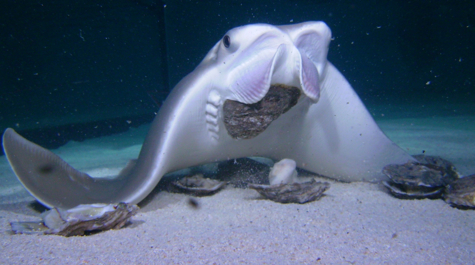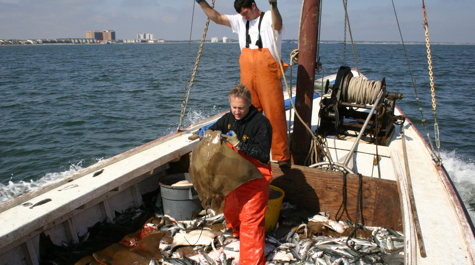Cownose Ray Management
Researcher applies findings to ray management
Compare humans to cownose rays, and you might spend so much time listing differences, you’d overlook their most important similarity—both eat shellfish. This competition causes concern among Chesapeake Bay’s shellfish growers whose oysters, scallops, or clams might fall onto the plates of cownose rays instead of humans.
There are several management practices that may help to alleviate their worries. Bob Fisher is researching cownose rays to develop approaches that stave off income loss to shellfish growers while ensuring the sustainability of the Chesapeake’s cownose ray populations.
Fisher is a Fisheries Specialist with Virginia Sea Grant at VIMS. His research explores everything from ray growth and social behavior to devices that may act as cownose ray repellants. All of these aim to help resource managers and scientists choose appropriate management techniques for limiting rays’ impact on commercial shellfish beds.
Fisher suspects that magnetic fences could be used to deter rays from entering a shellfish bed. Rays have a specialized organ called the Ampullae of Lorenzini that allows them to detect weak electrical fields at short ranges. The organ comes in handy as rays search the floor of Chesapeake Bay for prey, but Fisher suspects that over-stimulating the organ with magnets could cause rays to change direction to avoid the magnetic field.
When Fisher tests this idea using captive rays, the rays initially avoid prey that is surrounded by magnets. However, after several minutes of exposure, the rays seem to get used to the magnets, what biologists call “habitualization.”
“In the wild, that may not be the case,” Fisher says. “Wild rays may detect the magnetic field and completely avoid the area and swim downstream.” Fisher hopes to test the magnets in Chesapeake Bay next spring.
Another option may lie in developing a market for cownose rays as a seafood product. Fisher says that although demand for ray meat may be low today, there’s the potential for a fishery to develop.
“Similar ray species are harvested in other regions in the world,” he says. “So this species warrants biological assessment.”
The biological assessment aspect of Fishers’ work includes gathering information about rays’ population, growth, and behavior, all of which could help resource managers develop a sustainable fishery plan. Currently, the population of the cownose ray is unknown, and the species is slow to reproduce. Cownose rays do not reach maturity until they are 5 to 7 years old, and mature females produce only one offspring per year. This means the population may not be able to replenish itself quickly enough to cover demand for cownose ray meat.
It is also important to consider rays’ migratory behavior and reproductive cycle.
“The animals come into Chesapeake Bay [in the spring] when the embryo is not at term,” Fisher says. The rays live in the Bay for several weeks before giving birth. Shortly afterward, they mate again before they migrate out of the Bay for the winter. So the timing of harvest could affect the rays’ population.
“Whether we develop a ray fishery or not, it is important that we do the research so we can make these decisions without impacting the population in a negative way,” Fisher says.


